The circle of fifths can tell us a lot about musical keys as well as harmony – let’s discuss!
Over 100,000 guitar-learners get our world-class guitar tips & tutorials sent straight to their inbox: Click here to join them
In this free lesson you will learn…
- The significance of the circle of fifths
- Why you need to learn it
- How to understand intervals
- How to use the circle of fifths to understand chords
Welcome To Your Beginner’s Guide To The Circle Of Fifths
One of the things that is so much fun about learning how to play guitar is that we can begin playing songs right away.
All we need to do is figure out how to read chord charts, maybe learn a few notes on the strings, and we can play some songs almost immediately.
- After a while, we can even see some patterns start to emerge in the songs we play.
- Sometimes the same chords appear over and over again.
It seems like there’s some overarching system or structure to how all these songs work, how they’re built, why the same things keep happening in songs that are otherwise very different.
Oh, wait. There is.
Let’s discuss.

There are many ways to approach this question of the structure of music, and you can try every way you find, but the circle of fifths is as good a way as any to start to understand how music works.
- Perhaps you’ve heard the phrase “circle of fifths” before, and maybe you’ve even seen one and thought, “Well, that’s just a bunch of notes that are just out of order.”
- The circle of fifths is really the Rosetta Stone of music and can give you some insight (or at least some shortcuts) to understanding how songs are put together so that they sound good.
After this lesson, you’ll know enough about the circle of fifths to see it in action in every song you play!

Circle Of Fifths: What’s A Fifth?
The circle of what?
In order to understand what a fifth is, you need to know just a little bit about intervals.
An interval is a way of naming the relationship between two notes, whether they are played/sung at the same time or in sequence.
That relationship is expressed in two words, like “perfect fifth” or “major third.”
✅ Stop struggling. Start making music. ✅ Learn beginner-friendly versions of every chord. This is our most popular guide and it will improve your chord ability quickly! 😎 Get a custom guitar-learning plan here: Click here for GuitarMetrics™ Learn from the world's best guitar educators: Click here for our guitar coursesLearn 12 EASY beginner chords with our popular guide

Get your own personalised guitar-learning plan 🎸
World-Class Guitar Courses 🌎
Interval Quantity & The Musical Alphabet
We measure the distances between notes, and call them intervals.
For example, A to C is called a third.
The musical alphabet goes from A to G and then starts over again at A as we go up in pitch, right?
So to find the quantity of an interval, you assign the “first” position to the note that’s lower in pitch, and then you count up until you find the position of the note that is higher in pitch.
If you have a G and an E, and the E is higher than the G, you assign G “first.”
A is second, and so forth, and you’ll find that E is sixth. So, the quantity name of that interval between G and E is a sixth. Simple as that!

Interval Quality & Half-Steps
The other word in an interval name is the quality. The quality further specifies how the interval should sound.
We get the quality name of the interval by measuring half-steps between the notes. For example, A to C is three half-steps, and that’s called a minor third.
- A to C# is four half-steps, and that’s called a major third.
- This is important because as anyone who’s executed a near miss on a guitar knows, one half-step (one fret) makes a huge difference in sound.
- There are two groups of intervals. Seconds, thirds, sixths, and sevenths can be either minor or major.
The major interval is one half-step farther apart than the minor interval.
Unisons, octaves, fourths, and fifths can be perfect, augmented, or diminished.
Well, sevenths can also be diminished, but that’s a discussion for another lesson.

So, A Fifth Is An Interval!
A fifth is an interval. There are three kinds of fifths, only one of which is really relevant to the circle of fifths.
The augmented fifth is what you get when you have a C and a G#. Those usually only come into play when you are talking about augmented chords.
- There are also diminished fifths, which is what you get when you have a C and a Gb.
- Those are useful mainly in the arenas of dominant seventh chords, diminished chords, and emergency vehicle sirens.
- What we’re talking about in the ‘circle of fifths’ is the perfect fifth.
When you have a C and a G, you have a perfect fifth.

How Do I Know Whether A Fifth Is Perfect?
There are a couple of easy ways to figure out the quality of a fifth, whether it’s augmented, diminished, or perfect.
- If you’re counting half-steps, there are seven half-steps in a perfect fifth.
- Are you ready for an amazing fun fact about the guitar?
That’s why there’s a dot on the seventh fret!
Go from any open string to that string on the seventh fret, and you’ve got a perfect fifth!
A diminished fifth, as its name suggests, is one fewer half-steps (six).
An augmented fifth, as its name also suggests, is one more half-step (eight).
If you want to be able to manufacture a perfect fifth out of thin air like a magician, all you have to do is begin singing “Twinkle Twinkle Little Star.”
The jump in notes between the first and second Twinkles is a perfect fifth!
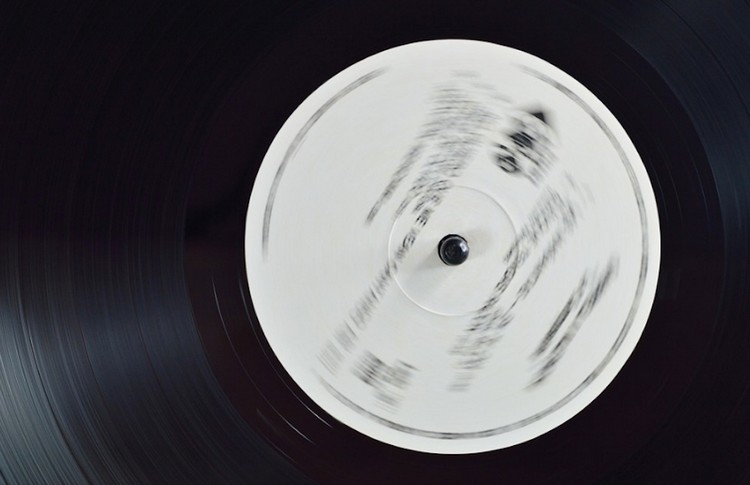
Pro-Tip: Intervals are really the heroes of figuring out how music works.
Learning to play specific intervals on your guitar will help you to learn things by ear, write the melodies you want, and just plain play better!
Circle Of Fifths: Why A Circle?
When we’re introduced to the world of notes, it’s frequently in the form of the chromatic scale.
That’s the organization of the 12 tones of Western music in order of pitch.
In other words, as you go up the chromatic scale – A, A#, B, C, C#, D, D#, E, F, F#, G, G# – you go up in pitch by a half-step.
Well, that makes sense, and it’s useful to see how pitch increases in an orderly way.
- As well, the chromatic scale is a super easy thing to map out on one string of your guitar and even across the whole fretboard.
- The chromatic scale does not, however, do a very good job of organizing the notes in an order that shows how those notes relate to each other or sound good together.
- We already know that two notes that are just one fret apart don’t sound very good together.
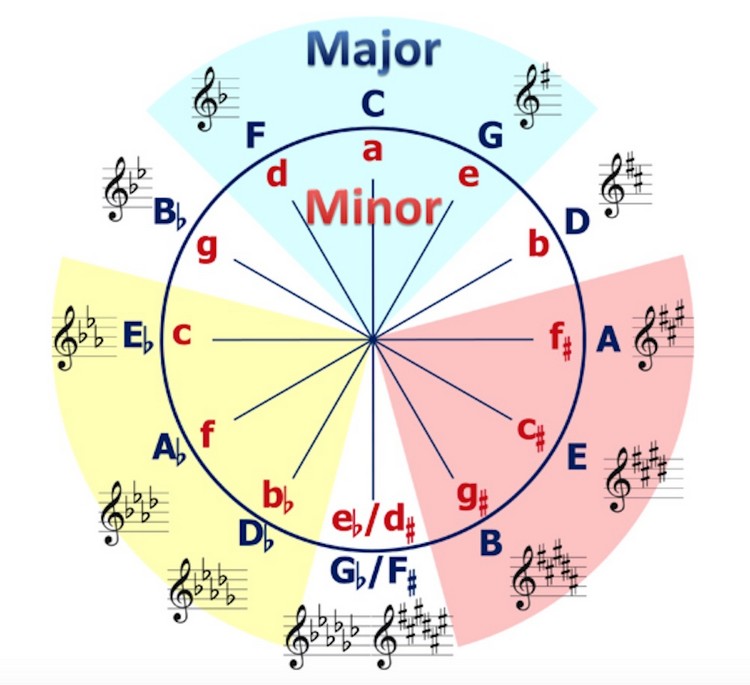
The circle of fifths arranges the notes of the chromatic scale in fifths, hence the name.
- As you go clockwise around the circle of fifths, each consecutive spot is another ascending fifth.
- Noon is C, and one o’clock is G. That’s a perfect fifth.
- As you go counterclockwise around the circle of fifths, each consecutive spot is another descending fifth.
Some people choose to call the counterclockwise direction the circle of fourths, but it’s really the same thing.
There are three main aspects to the circle of fifths that are significant and useful to understanding how music works: notes, chords, and keys.

Circle Of Fifths: The Notes
To understand why fifths are a big deal, let’s talk for a second about consonance and dissonance. We promise to keep it short.
- In music, consonance and dissonance are sort of a range of how good things sound together.
- At the consonance end, we’ve got the unison – the same note – and the octave – the next iteration higher lower of that note.
- At the dissonance end, there’s the half-step.
The half-step is extremely important and useful, but if you play two notes that are a half-step apart, they sound like they are fighting, and that’s almost as dissonant as you can get.
For mathematical reasons we don’t need to get into (but this guy will), a perfect fifth is over at the consonance end of the spectrum.
It’s the strongest, closest, nicest-sounding pair of notes next to the unison and octave.
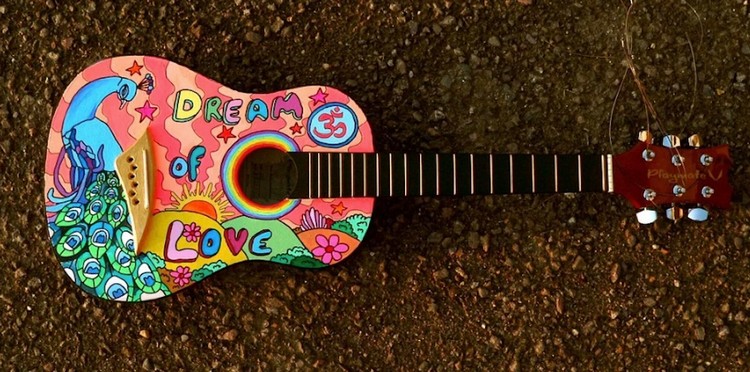
So when we go around the circle of fifths, we get notes that sound very consonant, very good together. You might even say perfect.
- There are about 12 centuries of music history behind the use of the fifth as harmony, but we’re still using the fifth today to organize our music.
- The practical advantage of the circle of fifths is that the closer to each other in the circle any two notes are, the better they sound together.
Go directly across the circle of fifths and you’ve got the tritone – the devil’s interval!

Circle Of Fifths: The Chords
Since the circle of fifths organizes notes according to consonance, it makes sense that when you build chords on top of those notes, the arrangement stays the same.
In diatonic harmony, we’re using only the notes in any given major scale to form chords. So in the key of C major, we’ve got a chord for C, D, E, F, G, A, and B. Except we mostly ignore B.
When we follow that formula, we can convert the diatonic harmony chords into numbers.
As a matter of fact, here’s a nifty little major scale chart that does all the work for you so you don’t have to:
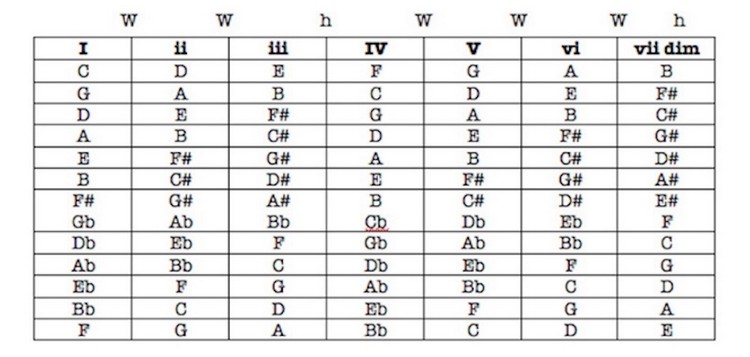
Check out the roman numerals at the top.
Perhaps you’ve seen them before. Here’s what they mean:
- The capital roman numerals represent the major diatonic chords. When you’re in a major key, the I, IV, and V chords are all major chords (upper case).
- The ii, iii, and vi chords are all minor (lower case)
- The vii is diminished. Ignore that one for now; it’s just there to complete the picture, but not yet practical.
There are a couple of ways that you can use the circle of fifths to circumvent having to memorize all the notes and chords in all the scales.
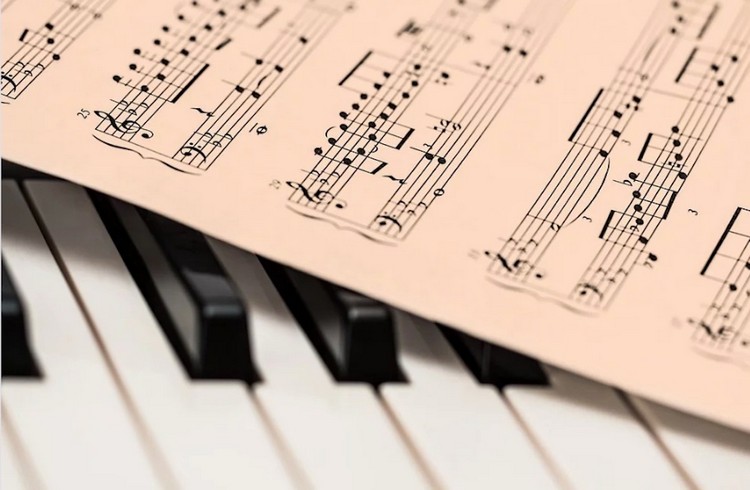
Using The Circle Of Fifths To Resolve Chords
Chords move through songs to create places of tension and resolution.
The ultimate resolution is when a song lands on the I chord.
- Since we’re looking at the circle of fifths, the easiest thing to do to see how it works is to play two adjacent chords going counterclockwise.
- Play the A chord, then the D chord.
You’ll hear the A chord teeing up the D chord so that when you play the D chord, it sounds like it’s come in for a landing.
That’s resolution. The circle of fifths is a way to use chords to set up other chords to give the song direction.

Organization Of Chords In The Circle Of Fifths
So if we’re in the key of D major, we know that D is the I chord and A, one spot clockwise, is the V chord.
- The other chord which appears all the time in songs is the IV chord. In D, that’s the G chord, and look where it is: one spot counterclockwise.
- If you look at the inner circle of notes in the circle of fifths, those are where you find the minor chords.
In the key of D, the vi chord and also the relative minor of D is Bm, directly inside the D chord.
That area of the circle of fifths – whichever key you’re in and the adjacent spots on either side – contain all the usable chords within a key!
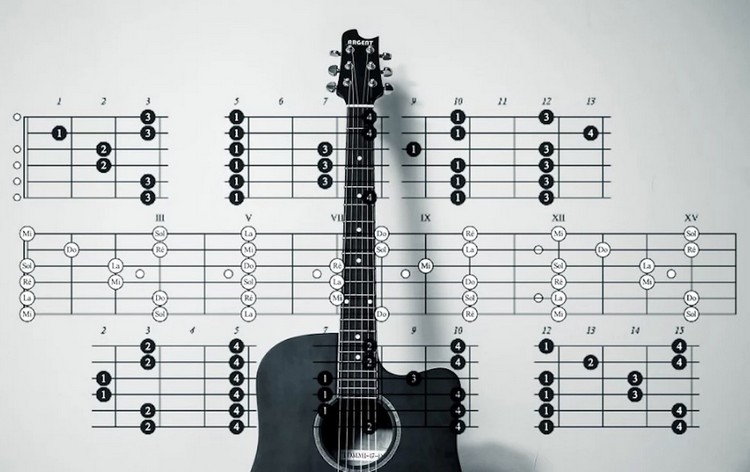
It's hard to understand which scales work with which keys.
So we created a cheat-sheet! A key and scale-finder that you can use again and again.
Get a custom guitar-learning plan here: Click here for GuitarMetrics™ Learn from the world's best guitar educators: Click here for our guitar coursesDownload our lead guitar cheat-sheet to make things easier

Get your personalised guitar-learning plan 🎸
World-Class Guitar Courses 🌎
Circle Of Fifths: The Keys
Another thing that happens not too infrequently in songs is a change in key, especially when we’re trying to play longer pieces.
Knowing about the relationship between keys is the same thing as knowing about the relationship between scales, so the circle of fifths is a good guide to how far “outside” you want to go when you’re improvising.
- The circle of fifths above contains the key signatures for each spot.
- C is in the noon position because it doesn’t have any sharps or flats.
As you go around the circle of fifths clockwise, you see the sequence of keys in increasing order of sharps:
G has one sharp, D has two, all the way down to F#, which has six. C# has seven, but only classical composers and people who hate us write in C#.
As you go around counterclockwise, the sequence of keys goes in increasing order of flats: F has one, Bb has two, and on down to Gb, which has six.

- The inside circle of keys shows the relative minor.
- The C major scale has no sharps or flats, and neither does the A natural minor scale.
- Each major key has a companion relative minor that shares the same key signature.
- Play the notes of the B major scale starting on a G#, and you have the G# natural minor scale.
As you go in either direction around the circle of fifths, each consecutive spot has only one note that is different than the spot before it.
The further you go around the circle of fifths, the fewer notes those keys have in common, so if you really want to go outside, take a chance on a scale a few spots away!

To Understand The Circle Of Fifths, Use It!
It can take a good while for guitar players to memorize all of the names of all of the notes in all of the scales.
The circle of fifths is a great starting point because it has the shorthand for all of that information in a format that you can use right away.
If you’d like more information on the circle of fifths, check out this friendly and informal video by Rick Beato.
Recommended resources
If you enjoyed this lesson on the Circle Of Fifths, check out some of our other free content below!
- Music Theory For Beginners
- Reading Guitar Music
- Guitar Keys
- Guitar Chords
- Best YouTube Guitar Lessons
Take our 60-second quiz & get your results: Take The Quiz Click here to learn more about National Guitar Academy membership Look cooler! Check out our merch: Click here to see our merch store Join over 100,000 guitar-learners and subscribe to our guitar-tips-by-email service. (It's free.) We'll send you a series of lessons that will move you to the next level of your guitar journey. Learn how everything fits together quickly, easily and effectively. We share ninja tips (for instant fun!) but also timeless fundamentals that will deepen your understanding.What Type of Guitarist Are You?
Join the world's best online guitar school 🌎

Cool Guitar T-shirts 😎
Want free guitar tips and video lessons delivered to your inbox?

How To Learn Guitar: An 11-Step Programme For Beginners How To Choose The Perfect Beginner Guitar Learn about National Guitar Academy: About Us Join us on Facebook for daily guitar tips. Listen to our Learn Guitar Podcast for rapid guitar progress. Check out our free chord lessons.Popular Lessons
More Cool Guitar Stuff
Get our best guitar tips & videos
Where should we send it?
Where should we send it?
Get our best guitar tips & videos


